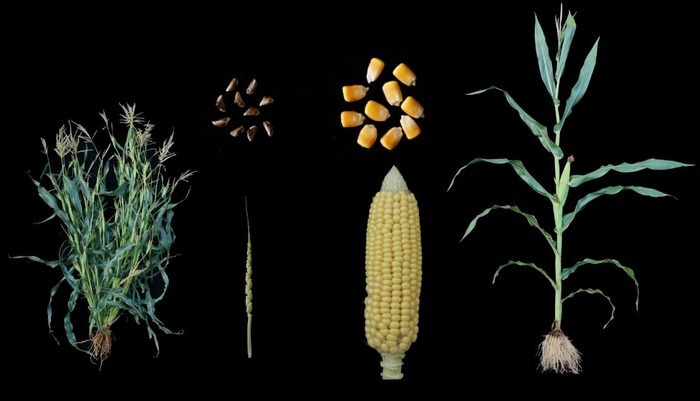The wild ancestor of maize, teosinte, contains three times as much seed protein as the majority of cultivars of maize today. The mechanisms causing the declining seed protein content in maize hybrids and inbred lines were identified by researchers at the Chinese Academy of Sciences Headquarters.
 Wild maize (left) and modern maize (right). Image Credit: CEMPS
Wild maize (left) and modern maize (right). Image Credit: CEMPS
Their research opens up new opportunities for future maize breeding to increase seed protein content and quality, with implications for nitrogen-use effectiveness and food security.
The results of the study were released on November 17th, 2022 in Nature.
There is economic and environmental pressure to maintain high-yielding maize while reducing the level of nitrogen applied to the soil. Therefore, it is crucial to identify genetic factors that increase nitrogen-use efficiency.”
Yongrui Wu, Study Author, Center for Excellence in Molecular Plant Sciences, Chinese Academy of Sciences
Plant breeders have been genetically modifying plant species over millennia to produce seeds with higher proportions of metabolites to increase nutritional value and utility. Plant breeders gave starch content and yield the highest priority over protein content and flavor as corn became a significant source of feed for livestock.
The significance of seed nitrogen content was further diminished by the use of nitrogen fertilizer. As a result, the study found that teosinte has a protein content of 20–30% while modern maize hybrids only contain 5–10% protein.
Scientists can identify the decline in protein content in maize seeds, but the underlying genetic causes are still unknown. By constructing a complete genome sequence for teosinte, Wu and a group from the Chinese Academy of Sciences Headquarters set out to identify the genes accountable for the difference in protein content between teosinte and maize.
The researchers were able to locate the quantitative trait locus (QTL), or the particular chromosomal regions that are linked to the desired traits, by breeding teosinte with maize and examining the offspring.
Wu stated, “Because modern maize was domesticated from teosinte, we reasoned that characterizing the genes responsible for the high-protein trait in teosinte might reveal a more diverse set of QTLs than those found in recent inbred maize populations. The results might also help us to understand the reasons for the decrease in seed protein content during the domestication of maize.”
On chromosome 9, the researchers focused on a significant high-protein QTL. The asparagine synthetase 4 (ASN4) enzymes, which are crucial for the metabolism of nitrogen, are encoded by the teosinte high protein 9 (THP9) QTL, which also showed the strongest effect during QTL mapping.
Previous research on rice, wheat, and barley demonstrated that variations in these genes’ expression affect plant growth and nitrogen content.
Due to incorrect splicing of the gene transcripts, the THP9-teosinte (THP9-T) gene variant (allele) is highly expressed in the roots and leaves of teosinte, but not in the corresponding maize inbred, according to Wu.
“This might be one of the factors that leads to differences in nitrogen assimilation. Amino acids are essential substrates for protein synthesis, and their levels in the plant are influenced by soil nitrogen availability and the nitrogen use efficiency of the plant,” Wu added.
The team conducted field tests to demonstrate that the THP9-T allele could improve nitrogen-use efficiency in both high- and low-nitrogen environments. Further research revealed that THP9-T could be used in plant breeding to increase the protein content of maize seeds and plants.
Wu concluded, “Our research shows the possible value of hybrids that contain the THP9-T allele, although larger field trials in multiple geographical locations will be needed to fully establish its potential for improving seed protein content and nitrogen-use efficiency in maize breeding.”
Source:
Journal reference:
Huang, Y., et al. (2022). THP9 enhances seed protein content and nitrogen-use efficiency in maize. Nature. doi.org/10.1038/s41586-022-05441-2